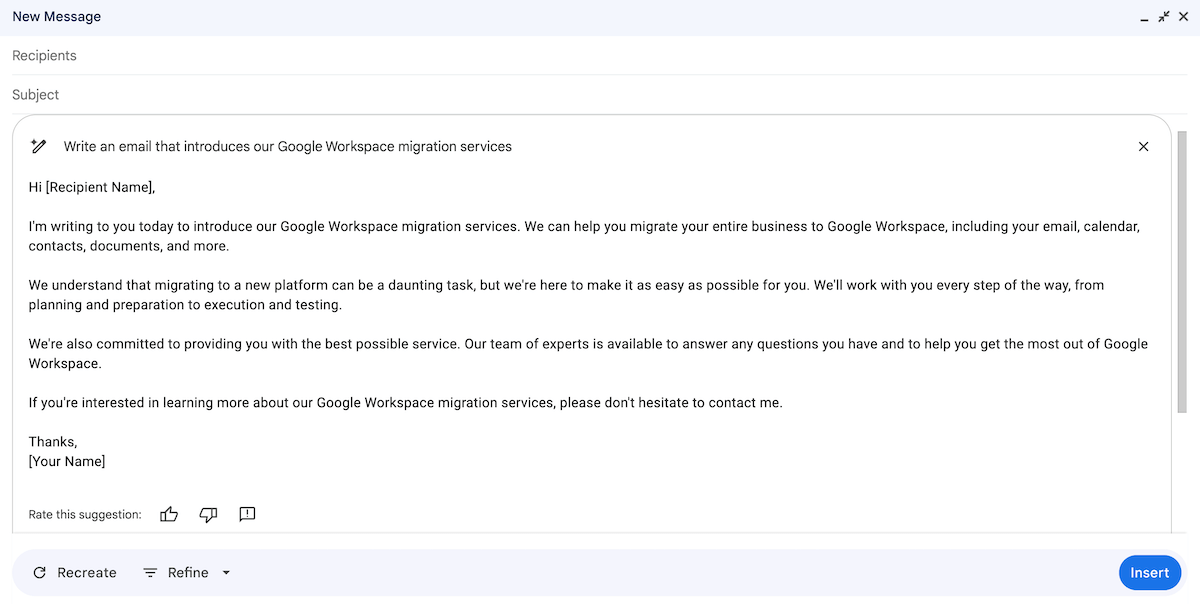It took less than a decade for Google to dominate the internet search engine market.
Today, Google’s business productivity suite, Google Workspace (formerly G Suite), has over 10 million paying customers.
It all started in the mid-1990s when Stanford graduate Larry Page noticed something the other internet search engines were missing. Popular search engines at the time hadn’t accounted for the number of incoming links each webpage had.
Page believed that the number of incoming links should influence a webpage’s search engine results page ranking. This led to the creation of BackRub. BackRub was a program that indexed pages on the web and recorded how many links they had to other sites.
Once BackRub was up and running, Page teamed up with Sergey Brin, a fellow Stanford graduate, to create the PageRank algorithm.
The PageRank algorithm used data generated by Backrub to rank webpages based on how well they linked with other web pages. Combined, BackRub and the PageRank algorithm made up the foundation of the Google we know today.
In 1996, Page and Brin launched Google on the Stanford University website. While initially successful, the search engine quickly used up half of Stanford’s bandwidth, and once even brought down the entire site.
In September 1998, Page and Brin founded Google LLC. The name comes from the term “googol”, which is the digit “1” followed by a hundred zeros.
In the twenty-three years since its launch, Google’s parent company Alphabet has rapidly expanded to become the third-largest tech company in the world, by market cap. Google now has eight products that each have more than a billion users, one of which is Google Workspace.
But long before there was Workspace, there was Google Apps for Your Domain.
2006 – Google Apps for Your Domain Launches
On August 28th, 2006, Google launched Google Apps for Your Domain, which was free for all. The initial package included several apps that have evolved into the Google Workspace apps many people use today, including:
Gmail – Gmail was initially launched in 2004. Gmail was free and offered users 1GB of storage space, which was significantly more than its competitors at the time. It was also the first email client that strung related emails together in a conversation, a standard often overlooked today.
Talk – Talk which was an IM application, provided users with text and voice messaging capabilities. The Talk app was eventually incorporated into the Hangouts app in 2013.
Calendar – Google’s fully online calendar. The app was launched in 2006 and designed to integrate with Gmail, allowing users to quickly add events from their email to their calendars.
Page Creator – website creation and hosting application. The app enables users to create basic web pages without prior knowledge of HTML or CSS. Page Creator was eventually replaced with Google Sites in 2008.
In October 2006, Google introduced an apps package for schools, called Google Apps for Education. Later in 2006, Google purchased YouTube for $1.65 billion.
October 2006 was also the official birth month of Google Docs, as evidenced by this celebratory video from October 11, 2021:
2007 – Google Apps Premier Launches
Up until 2007, Google Apps had been free for all users. However, in February 2007, Google introduced its first paid version of its app platform, known as Google Apps Premier.
The paid version offered 10GB of extra storage per user and APIs for businesses to integrate Google’s apps with their existing software.
The premier edition costs $50 per user per year, and early adopters included Salesforce and Procter & Gamble.
Google also released the first full versions of Docs, Spreadsheets, and Presentations for paid and free Google Apps users.
Docs was built on a foundation called Writely, built by a team led by Sam Schillace. The release date was August 2005. Google acquired the company and its software in 2006. Unlike its rival, Microsoft Word, Docs is an online-first word processor.
Presentations was Google’s version of Microsoft PowerPoint. It came from Google’s acquisition of Tonic Systems in April 2007. Presentations was renamed Slides in 2012.
Spreadsheets, rebranded as Google Sheets in 2012, was Google’s answer to Microsoft Excel. Google released the program after acquiring the app’s developer, 2Web Technologies.
2008 – Google Sites Introduced
In February, Google announced the replacement of Google Page Creator with Google Sites. Sites was based on an acquisition of JotSpot in 2006.
Sites is a web-based app that provides features like team websites and intranets on top of the site-building functionality in Page Creator.
2009 – The Full Launch
Google announced that Google Apps was no longer in beta testing.
2010 – Marketplace and Government Edition Launched
In March, Google successfully launched Google Apps Marketplace. The Marketplace allowed third-party developers to build applications to work with Google Apps.
In July, Google released Apps for Government Edition. Google designed this edition to meet the hyper-strict security guidelines of public sector software.
Google Apps was the first cloud-based app platform to receive Federal Information Security Management Act certification. This showed that the Apps met the highest information security standards.
Google also acquired the software company DocVerse in 2010. DocVerse enabled users to collaborate live on Microsoft Office programs, such as Word and Excel. At the time, Google correctly believed that the future of office work lay in the cloud. The DocVerse plugins helped Google Apps compete with Microsoft Office.
2011 – Reduced Free Features
As of April 2011, companies with more than 10 users were no longer eligible for the free version of Google Apps. Instead, they would have to sign up for Google Apps for Business.
Google Apps for Business cost $5 per month per user and allowed for flexible billing, which was uncommon at the time. Microsoft was still selling its Office products for hundreds of dollars upfront.
2012 – Google’s Answer to OneDrive
In April, Google launched Google Drive, also called G Drive. Each user was given 5 GB of free storage space, with the option to purchase additional storage.
Later, the storage space was unified between Gmail and G Drive, allowing each user to access 30GB of storage across both apps.
2013 – Improved Collaboration
Google released Hangouts as a standalone communication and collaboration product. Although Hangouts was popular, it was replaced with Talk and Meet in 2020 with the release of Workspace.
2015 – Restructuring the Business
In August 2015, Google announced its plans to create a new holding company called Alphabet.
The restructuring would move Google’s subsidiaries to Alphabet’s control, narrowing Google’s focus and scope. The move allowed Google and other Alphabet subsidiaries to be managed by separate CEOs.
2016 – Google Apps Rebrand
In September 2016, Google Apps was renamed G Suite. Google wanted to promote Google Apps as compared to traditional office program suites, like Office.
In 2016, Google announced new Google Sites. This would eventually replace the initial version of Sites, which came to be known as “Classic Sites.”
2017 – Improved Online Meetings
Google Meet was formally introduced in 2017. Meet and Chat eventually replaced the team communications app Hangouts.
2019 – New Product Leadership
In October 2019, Javier Soltero became Vice President and General Manager of Google Workspace.
Soltero had been Corporate Vice President at Microsoft for Outlook and the Office Product Group.
2020 – Google Workspace Announced
Under Soltero’s product leadership, Google announced G Suite was to be renamed Google Workspace to reflect the changing nature of office work. Workspace unified all of Google’s production and communication apps into a single platform for business collaboration.
Google Workspace was repositioned as a hub designed for remote teamwork. As of April 2020, Google Workspace had 6 million paying customers.
2021 – A Collaborative Remote Work Platform
In June 2021, Google announced that Workspace would be made available to anyone with a Google account in the form of Workspace Individual.
The universal @ menu was added to Google Docs. Users could now easily add smart chips for dates, events, people, files, etc.
2022 – AI For Getting More Work Done
In 2022, Google continued to roll out AI-driven features for productivity. These included the introduction of automated summaries in Google Docs and Spaces. AI also improved the online meeting experience with automatic adjustments to audio and video.
The end-of-life date for Classic Google Sites was announced as January 1, 2023.
2023 – Embedded Generative AI
In September 2023, Google announced the general availability of the paid add-on ‘Duet AI for Google Workspace Enterprise’ — since rebranded ‘Gemini.’
Google called Gemini “a powerful collaborator that can act as a coach, thought partner, source of inspiration, and productivity booster.”

2024 – Doubling Down on AI
Among the announced enhancements at Google Cloud Next 2024 were:
Google Vids — a new AI-powered video creation tool that helps users create and share videos at work. It offers features like storyboard generation, scene suggestions, and voice-over options, making it a comprehensive tool for video production and editing within Google Workspace.
Gemini integration into the side panels of Google Docs, Sheets, Slides, and Drive. This provides capabilities such as content summarization, analysis, and generation within these apps. It helps users streamline their workflows without needing to switch between different applications.
2025 – More AI-Powered Productivity and Enhanced Security
In 2025, Google Workspace underwent a significant transformation by integrating Gemini AI across Gmail, Docs, Sheets, Chat, and Meet. This integration introduced features like contextual Smart Replies, AI-generated charts in Sheets, and automated meeting notes in Meet.
A notable announcement at Google Cloud Next 2025 was Google Workspace Flows, an AI-driven automation tool that enables users to create custom workflows using ‘Gems’—specialized AI agents capable of handling complex tasks such as drafting emails, analyzing documents, and managing support tickets.
Security also saw advancements with the introduction of end-to-end encryption (E2EE) in Gmail for enterprise users, which simplifies the process of sending secure emails and reduces the reliance on third-party tools.
Alphabet Financials and Google Workspace
The majority of Alphabet’s revenue continues to come from Google advertising. In Q4 2023, advertising earnings were just over seven times Google Cloud revenue.
The Google Cloud business unit includes Google Workspace.
Here is Google Cloud’s operating revenue across some recent quarters:
| Quarter | Operating Revenue |
|---|---|
| Q2 2022 | -$590M |
| Q2 2023 | $395M |
| Q4 2023 | $864M |
| Q2 2024 | $1,172M |


